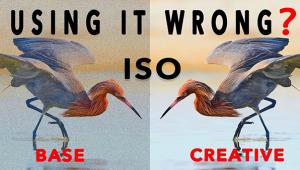Many Roads To Travel
As the mixed bag of camera reviews in this month’s issue shows, there are many ways you can travel the photographic road these days. These range from the arcane to the elaborate, from pocket-sized digicams with extensive controls to full-fledged pro systems with interchangeable film/digital backs. The system you choose will necessarily match what you like or need to capture, be it casual shots on an extended trip or commercial work for a client. Sorting through all that’s available to you in each “segment” is the tough part, what with the advances in technology that seem to bump one camera off the shelves in short order for the latest manifestation with ever-higher megapixels, a new tonal curve control, or HD video added into the mix.
 There are some clear delineations that help sort all this out. In digicams (integral lens cameras) there’s megapixel count (where to me the law of diminishing returns eventually weighs in), the degree of user control, and add-on features that might make a difference to you, such as the options in Scene modes, wireless connectivity, and even the level of video recording the camera delivers. In D-SLRs there’s a bit of fuzzing at the borders, but you can generally choose among amateur (about $500), advanced amateur (hovering between $900 and $1200), and pro models, those with full-frame sensors and a heftier build. But throw in Live View, video capability, and wireless flash capability and you have a lot more choices to make.
There are some clear delineations that help sort all this out. In digicams (integral lens cameras) there’s megapixel count (where to me the law of diminishing returns eventually weighs in), the degree of user control, and add-on features that might make a difference to you, such as the options in Scene modes, wireless connectivity, and even the level of video recording the camera delivers. In D-SLRs there’s a bit of fuzzing at the borders, but you can generally choose among amateur (about $500), advanced amateur (hovering between $900 and $1200), and pro models, those with full-frame sensors and a heftier build. But throw in Live View, video capability, and wireless flash capability and you have a lot more choices to make.
Simply put, you have to plant your flag somewhere, and usually that comes down to budget and need rather than any wish list you might have created. You should also include your future plans or hopes, into which the system around the camera comes into play. Does the camera maker (and independents) offer a range of lenses, flash units, and other accessories that will allow you to grow your gear as your interest and endeavors expand? Do you see the camera you are investing in now as something that you can live and work with for a few years to come, or is it, in your best judgment, a transitional piece of gear that will soon be replaced by a major improvement in a few months’ time? Keep in mind that while economic conditions might be slowing some camera introductions (though the recent onslaught of new gear announced recently would seem to contradict that idea), camera makers often have plans for the next two generations of a camera already on the drawing board.
So what with APS-C, Four Thirds, Micro Four Thirds, full-frame sensors, and more versatile digicams coming down the pike, it is little wonder that it’s getting even harder to sort out the information to find the camera that’s just right for you. There are many resources for your research into these matters, and we hope to continue to do our part with reviews and tech updates as gear becomes available. We’ll continue to report on the major photo shows, and while the amount of gear we report on in those special issues can seem overwhelming, you will often find hints at what’s to come (except those we are constrained to discuss because of non-disclosure agreements) in our pages.
Next year we anticipate two things—a slew of new gear that’s been awaiting the economic fog to lift, and some exciting new imaging technology that is usually announced at or around the worldwide photokina show in the fall. But as I’ve stated before, it’s what you do with the gear, even the best gear in the world, and the images you make that are the most important matter. In the end, even the most arcane and alternative and even “ancient” camera can do the job, given that you take the time to explore your vision and make images that express how you see the world.

 There are some clear delineations that help sort all this out. In digicams (integral lens cameras) there’s megapixel count (where to me the law of diminishing returns eventually weighs in), the degree of user control, and add-on features that might make a difference to you, such as the options in Scene modes, wireless connectivity, and even the level of video recording the camera delivers. In D-SLRs there’s a bit of fuzzing at the borders, but you can generally choose among amateur (about $500), advanced amateur (hovering between $900 and $1200), and pro models, those with full-frame sensors and a heftier build. But throw in Live View, video capability, and wireless flash capability and you have a lot more choices to make.
There are some clear delineations that help sort all this out. In digicams (integral lens cameras) there’s megapixel count (where to me the law of diminishing returns eventually weighs in), the degree of user control, and add-on features that might make a difference to you, such as the options in Scene modes, wireless connectivity, and even the level of video recording the camera delivers. In D-SLRs there’s a bit of fuzzing at the borders, but you can generally choose among amateur (about $500), advanced amateur (hovering between $900 and $1200), and pro models, those with full-frame sensors and a heftier build. But throw in Live View, video capability, and wireless flash capability and you have a lot more choices to make.Simply put, you have to plant your flag somewhere, and usually that comes down to budget and need rather than any wish list you might have created. You should also include your future plans or hopes, into which the system around the camera comes into play. Does the camera maker (and independents) offer a range of lenses, flash units, and other accessories that will allow you to grow your gear as your interest and endeavors expand? Do you see the camera you are investing in now as something that you can live and work with for a few years to come, or is it, in your best judgment, a transitional piece of gear that will soon be replaced by a major improvement in a few months’ time? Keep in mind that while economic conditions might be slowing some camera introductions (though the recent onslaught of new gear announced recently would seem to contradict that idea), camera makers often have plans for the next two generations of a camera already on the drawing board.
So what with APS-C, Four Thirds, Micro Four Thirds, full-frame sensors, and more versatile digicams coming down the pike, it is little wonder that it’s getting even harder to sort out the information to find the camera that’s just right for you. There are many resources for your research into these matters, and we hope to continue to do our part with reviews and tech updates as gear becomes available. We’ll continue to report on the major photo shows, and while the amount of gear we report on in those special issues can seem overwhelming, you will often find hints at what’s to come (except those we are constrained to discuss because of non-disclosure agreements) in our pages.
Next year we anticipate two things—a slew of new gear that’s been awaiting the economic fog to lift, and some exciting new imaging technology that is usually announced at or around the worldwide photokina show in the fall. But as I’ve stated before, it’s what you do with the gear, even the best gear in the world, and the images you make that are the most important matter. In the end, even the most arcane and alternative and even “ancient” camera can do the job, given that you take the time to explore your vision and make images that express how you see the world.

- Log in or register to post comments

































